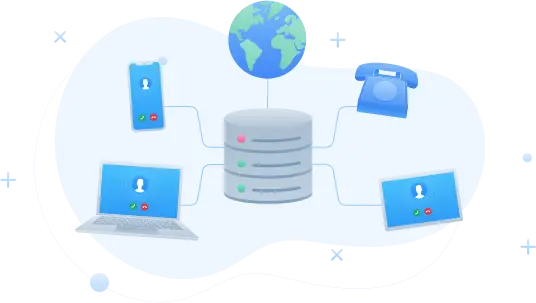IP (Internet Protocol) telephony is an Internet-based telephone system using VoIP (Voice Over Internet Protocol) technologies. It enables you to use a data network, such as the Internet or the Local Area Network, to make calls and exchange texts, images, videos, etc. Voice is digitized and grouped into digital data packets for transport over the network using IP.
IP telephony system components
The IP telephony system is based on several elements. System architecture varies according to need, but there is a basic architecture.
Codecs
These may be hardware peripherals or software processes. They enable data to be compressed, encoded and decompressed. They convert and compress voice signals into digital data packets that can be transported over the Internet. They are then used to convert them into an audio signal for the call receiver.
THE IP
This is the Internet protocol providing rules for transmitting and receiving data online. These rules are standardized, enabling devices running on different platforms to communicate. IP also provides basic rules for transmitting data packets. The local area network or LAN is the infrastructure to which VoIP terminals are connected.
VoIP Gateways
This equipment enables the connection between the IP network and the traditional telephone network. They can also be used to connect IP networks.
The PBX
PBX, or Private Branch Exchange, is the name of the private telephone network used. It’s also a software program that connects a company’s internal lines with external lines, the public telephone network. The PBX can be hosted locally or in the cloud. This PBX server is a software package for managing calls, telephony features, queues, voice mail…
Bandwidth
This is a network’s ability to transmit data from one point to another within a given timeframe. It is usually measured in 1000 bits per second. The higher the amount of bandwidth or the higher the data rate, the more VoIP calls the network can support.
Find out more about IP telephony network types, bandwidth requirements and management in our detailed article.
Softphone or IP phone
An IP phone is a handset or set of handsets used to make VoIP calls. It’s a landline or cell phone, a PC, a tablet, a smartphone… These devices are equipped with software called a “softphone”. This software converts voice into digital data and vice versa.
Setting up an IP telephony system
Setting up an IP telephony system is very simple. All you need is Internet access to make and receive calls from your phones. A dedicated application enables employees to use the company phone. They can initiate a call, transfer a call, set up a conference… Setting up the system varies according to the needs and characteristics of each company. There are, however, some basic steps.
Defining needs
To set up an IP telephony system, you first need to define your telephony requirements, call capacity, call management, security…
Choice of equipment
The hardware must be adapted to the IP telephony system. IP phones, IP gateways, Ethernet switches,
IPBX servers, cabling, etc. all need to be taken into account.
Network configuration
The network must be able to manage voice in real time, according to business needs.
Configuring telephony functions
Here again, telephony features need to be configured according to business needs. These include call management, queuing, voicemail, videoconferencing…
Safety
IP telephony system security must take into account firewalls, VPNs, necessary authentication… This is essential to protect the IP telephony system from external attacks or intrusions.
System testing, training and maintenance
Once the system has been tested to check that it is operating optimally, users need to be trained. Maintenance is also essential to ensure optimum performance over time.
The different architecture systems
There are different IP telephony systems.
IPBX architecture
It can be physical equipment. The IPBX (Internet protocol Private Branch eXchange) is a system that allows you to dispense with the traditional telephone network and create a company-internal telephone network via the Internet. With an IP telephony system, the IPBX is integrated into physical equipment installed in the company or data center. IP phones are connected to the IPBX server via the IP network. This solution provides centralized management of telephony functions.
Cloud PBX architecture
It can also be a software IPBX. The company’s IPBX is completely virtualized and can be installed in the chosen infrastructure, private or public. The system can be deployed in the Cloud, on virtual machines, on physical machines… IP phones are connected to a Cloud service provider providing telephony functionality. This solution is ideal for companies with employees who work remotely.
Hybrid architecture
It’s a blend of the two previous architectures. IP phones are connected to both a local IPBX server and a cloud service provider. This solution offers great flexibility and reduces the risk of breakdowns.
Gateway architecture
This architecture makes it possible to connect an existing conventional telephone network (PSTN) to an IP network. IP gateways convert analog voice signals into digital data so that voice can be transmitted over an IP network. It’s the ideal solution for gradually moving from a traditional infrastructure to an IP telephony system.
Peer-to-peer architecture
In this type of system, IP phones communicate with each other without going through a central server. It’s a solution used
by very small businesses or for communications between private individuals.









